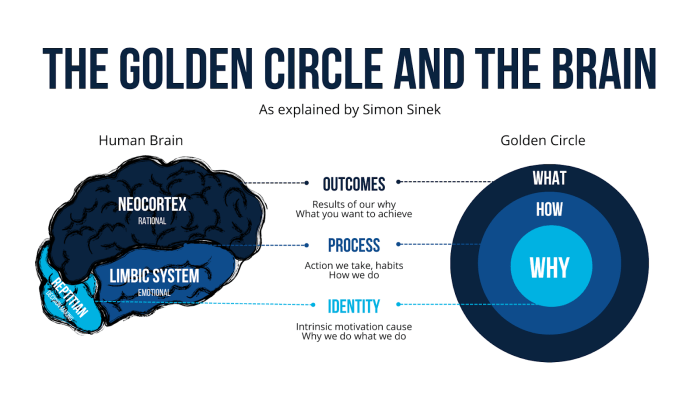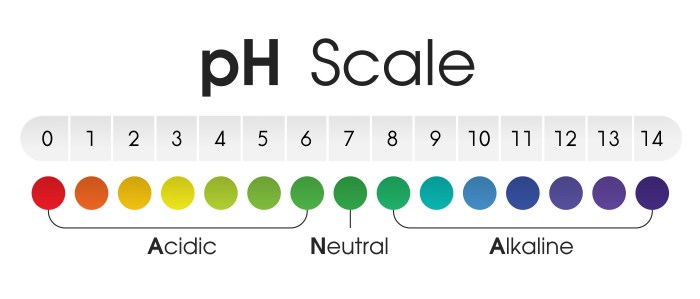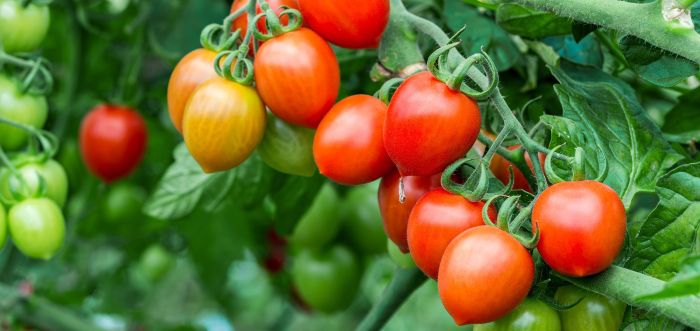Guide to fertilizing tomatoes: Unlocking the secrets to vibrant, bountiful tomato harvests starts with understanding how to feed your plants properly. This comprehensive guide delves into everything from the fundamental nutrients tomatoes need to the optimal timing and application methods, tailored for various growing environments. We’ll explore the world of organic and synthetic fertilizers, discuss soil testing, and even cover advanced strategies like slow-release options and foliar feeding.
From choosing the right fertilizer for your soil type to avoiding common mistakes, this guide provides practical advice for every gardener, whether you’re a seasoned pro or just starting out. Learn how to nourish your tomato plants for maximum growth and yield, maximizing your harvest and enjoying delicious homegrown tomatoes.
Introduction to Tomato Fertilization: Guide To Fertilizing Tomatoes
Feeding your tomatoes the right nutrients is crucial for bountiful harvests. Proper fertilization provides the building blocks for robust growth, vibrant foliage, and ultimately, delicious, juicy tomatoes. Understanding the essential nutrients and the different types of fertilizers available empowers you to tailor your approach to your specific tomato plants and soil conditions. A balanced approach, combining soil testing with fertilizer application, is key to achieving optimal results.Tomato plants, like all living organisms, require specific nutrients to thrive.
These nutrients, primarily nitrogen (N), phosphorus (P), and potassium (K), are the cornerstones of healthy growth and high yields. Knowing the role each plays is fundamental to successful tomato cultivation.
Essential Nutrients for Tomato Growth
Understanding the role of nitrogen, phosphorus, and potassium in tomato development is vital for maximizing yields. Nitrogen (N) is crucial for leaf growth and overall plant vigor. Phosphorus (P) is essential for root development and fruit production, while potassium (K) promotes strong stems, disease resistance, and enhances fruit quality. A balanced supply of all three is necessary for optimal growth.
Types of Tomato Fertilizers
There are two primary categories of tomato fertilizers: organic and synthetic. Organic fertilizers derive from natural sources like compost, manure, or seaweed, offering a slow-release of nutrients and improving soil structure. Synthetic fertilizers, on the other hand, are manufactured and provide a concentrated dose of specific nutrients. Choosing the right type depends on your gardening philosophy and the specific needs of your tomato plants.
Soil Testing for Tomato Fertilization
Soil testing is an indispensable step in tomato fertilization. A soil test provides a precise analysis of the nutrients present in your soil. This information helps determine which nutrients are deficient and how much fertilizer is needed to achieve the desired balance. This tailored approach prevents over-fertilization, a common pitfall that can harm plants. By understanding your soil’s needs, you can optimize your fertilization strategy for maximum effectiveness and minimize environmental impact.
Tomato Types and Fertilization Needs
Different tomato varieties have varying nutritional requirements. Determinate tomatoes, known for their compact growth habit and uniform ripening, often benefit from a more frequent, balanced fertilization schedule. Indeterminate tomatoes, which continue to grow and produce fruit throughout the season, might require more frequent and potentially higher doses of fertilizer. Understanding the growth characteristics of your chosen tomato variety is critical for optimizing its nutrition.
Choosing the Right Fertilizer
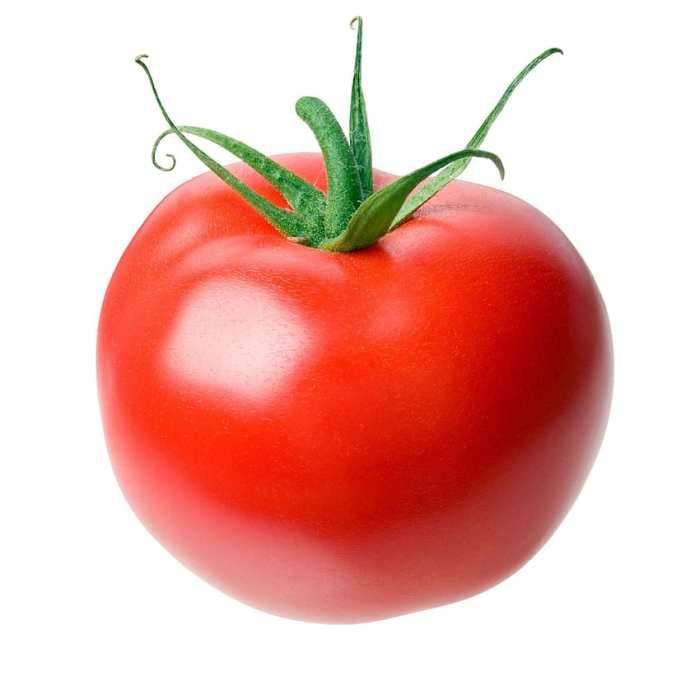
Selecting the appropriate fertilizer is crucial for maximizing tomato yield and ensuring healthy plant growth. Different soil types and tomato varieties react differently to various fertilizer formulations. Understanding the nuances of fertilizer selection allows gardeners to tailor their approach for optimal results.Choosing the right fertilizer is a crucial step in ensuring your tomato plants thrive. Factors like soil composition, desired nutrient levels, and your preferred fertilizer type will influence your choice.
Knowing the differences between organic and synthetic options, along with how to calculate the proper dosage, are key considerations.
Ideal Fertilizer Types Based on Soil Conditions
Different soil types require different fertilizer approaches. Sandy soils, for example, drain quickly and often lack essential nutrients. Clay soils, on the other hand, can hold moisture but may have poor drainage and aeration, hindering nutrient uptake. Understanding your soil type is essential to choosing a fertilizer that effectively delivers the right nutrients to your tomatoes. For sandy soils, fertilizers with a higher concentration of essential nutrients and a slow-release formula are generally recommended.
For clay soils, fertilizers with a balanced blend of nutrients and an enhanced ability to penetrate the dense soil are preferred.
Organic vs. Synthetic Fertilizers
Organic fertilizers, derived from natural sources, gradually release nutrients into the soil, promoting healthy microbial activity and soil structure. Synthetic fertilizers, on the other hand, provide a rapid release of nutrients, often in concentrated forms. Organic fertilizers generally have a lower nutrient concentration compared to synthetic fertilizers, requiring potentially larger applications. However, they offer benefits like improved soil health, reduced environmental impact, and potential long-term cost savings.
Synthetic fertilizers offer rapid nutrient delivery, but overuse can harm the environment and may not always improve soil health as effectively as organic options. Consider your priorities when choosing between these two options.
Nutrient Content Comparison
Different fertilizer brands offer varying nutrient concentrations. Comparing the NPK (nitrogen, phosphorus, and potassium) ratios on fertilizer labels is essential. For example, a fertilizer with a 10-10-10 ratio contains equal amounts of each nutrient, while a fertilizer with a 15-5-10 ratio has a higher concentration of nitrogen and potassium. Different tomato varieties might have specific nutrient needs.
Researching the ideal NPK ratio for your specific tomato variety can help you make informed choices.
Determining Fertilizer Dosage
Determining the correct fertilizer dosage is critical. Over-fertilizing can lead to nutrient burn, while under-fertilizing will result in stunted growth. Soil tests provide valuable insights into the existing nutrient levels in your soil. These tests indicate which nutrients are lacking or present in excess, guiding your fertilizer choices and dosages. Following the instructions on fertilizer packaging, coupled with soil test results, is a crucial step in achieving optimal tomato growth.
Comparison of Common Tomato Fertilizers
| Fertilizer Type | Ingredients | Pros | Cons |
|---|---|---|---|
| Organic Tomato Fertilizer (e.g., compost tea) | Compost, manure, seaweed | Improves soil structure, promotes microbial activity, environmentally friendly | Nutrient release is slower, may require larger application amounts, can be more expensive. |
| Synthetic Tomato Fertilizer (e.g., 10-10-10) | Nitrogen, phosphorus, potassium | Rapid nutrient delivery, readily available, often less expensive than organic options | Can harm soil microbial activity, may contribute to environmental pollution, potential for nutrient burn with over-application. |
Timing and Application Methods
Feeding your tomato plants consistently throughout their growth cycle is crucial for robust development and bountiful harvests. Proper timing and application methods are key to maximizing fertilizer uptake and preventing nutrient burn. Understanding when and how to apply fertilizer directly impacts the overall health and productivity of your tomato plants.
So, you’re looking for a tomato-growing guide? Knowing how to fertilize your tomatoes is key, but what if you don’t have a yard? Luckily, you can still grow amazing tomatoes even without outdoor space; check out this helpful guide on how to garden without outdoor space for inspiration. The right fertilizer, whether you’re using a balcony, patio, or indoor container, is still critical for healthy tomato plants.
This guide will give you the specifics on which fertilizer is best for your situation.
Fertilizing Schedule, Guide to fertilizing tomatoes
A well-structured fertilization schedule tailored to the growth stages of your tomato plants is essential. Different stages require varying nutrient needs. This targeted approach ensures your tomatoes receive the optimal nutrients at the right time. It also helps to prevent nutrient imbalances that can hinder growth.
- Early Growth (Seedling to First Set of Leaves): Focus on providing essential nutrients to establish a strong root system. A balanced, low-nitrogen fertilizer is ideal during this phase.
- Vegetative Growth (First Set of Leaves to Blossoming): Increase nitrogen content in your fertilizer to encourage foliage growth. This phase supports the development of healthy leaves and stems, crucial for the plant to flourish and produce flowers.
- Flowering and Fruit Set (Blossoming to Fruiting): Shift to a balanced fertilizer with a higher phosphorus and potassium content. These nutrients are vital for flower development and fruit production.
- Fruit Ripening (Fruiting to Harvest): Continue with a balanced fertilizer, but focus on potassium to support the ripening process. This stage requires nutrients to ensure healthy fruit size and flavor. Avoid high nitrogen levels during this time as it can lead to excessive foliage growth at the expense of fruit.
Application Methods
Choosing the right fertilizer application method is equally important. Different methods offer unique advantages in terms of ease of use, nutrient delivery, and plant health.
- Granular Fertilizers: These are often easy to apply and distribute evenly around the plant. They slowly release nutrients over time, providing a consistent feed for the plant. Apply granular fertilizer around the base of the plant, keeping it away from the stem and leaves. Water thoroughly after application to dissolve the granules and prevent potential fertilizer burn.
- Liquid Fertilizers: These are convenient for targeted feeding and are often more readily absorbed by the plant. Dilute liquid fertilizers according to package instructions to avoid nutrient burn. Apply the diluted liquid fertilizer to the soil around the plant, ensuring thorough watering afterward to prevent salt buildup. Applying to the leaves can cause burning if not diluted properly.
Watering After Fertilization
Proper watering after fertilizer application is crucial. It helps dissolve the fertilizer granules and prevents the build-up of salts in the soil, which can be harmful to the plant’s roots.
- Water thoroughly: Ensure the water penetrates deep into the soil, reaching the roots of the plant. This ensures that the fertilizer is properly distributed and absorbed.
- Avoid overwatering: While crucial, overwatering can also lead to root rot and damage the plant. Monitor the soil moisture and water only when necessary.
Placement of Fertilizer
Optimal placement ensures the fertilizer reaches the roots efficiently without damaging the plant. The location is key for maximum absorption.
- Around the base: Apply fertilizer around the base of the plant, creating a ring or band around the plant, but avoid touching the plant stem.
- Avoid contact with stems and leaves: Direct contact with the stems and leaves can lead to burning and damage the plant. Concentrate the fertilizer application to the soil surface.
Step-by-Step Application
A methodical approach guarantees even distribution and minimal plant stress. These steps detail how to apply fertilizer effectively.
- Assess the plant’s needs: Determine the current growth stage and nutrient requirements.
- Choose the right fertilizer: Select a fertilizer appropriate for the plant’s needs.
- Prepare the fertilizer: If using a liquid fertilizer, dilute it according to package instructions.
- Apply the fertilizer: Spread granular fertilizer around the base of the plant, avoiding contact with the stem and leaves. If using liquid, water the soil thoroughly after application.
- Water thoroughly: Water the area surrounding the plant to dissolve the fertilizer and encourage absorption by the roots.
Fertilizer Application Timing Table
This table provides a guideline for fertilizer application based on the tomato plant’s growth stages.
| Growth Stage | Fertilizer Type | Frequency |
|---|---|---|
| Seedling to First Set of Leaves | Balanced, low-nitrogen | Every 2-3 weeks |
| First Set of Leaves to Blossoming | Balanced, higher nitrogen | Every 1-2 weeks |
| Blossoming to Fruiting | Balanced, higher phosphorus and potassium | Every 1-2 weeks |
| Fruiting to Harvest | Balanced, higher potassium | Every 1-2 weeks |
Fertilizing Techniques for Different Growing Environments
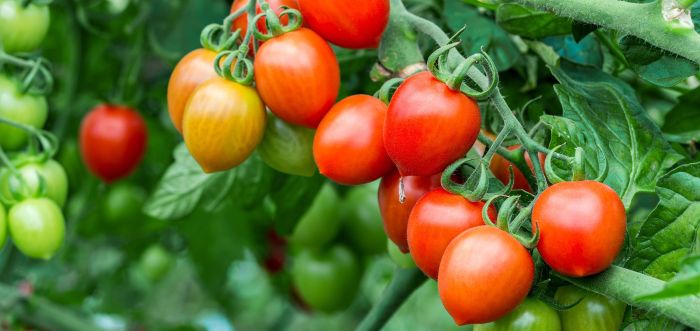
Tomato fertilization isn’t a one-size-fits-all approach. The specific needs of your tomatoes depend heavily on the growing environment. Whether you’re nurturing plants in containers, harnessing the power of hydroponics, or cultivating them outdoors, understanding the nuances of each environment is key to achieving optimal growth and yield.Different growing methods demand unique fertilizer strategies to maximize nutrient uptake and plant health.
So, you’re looking for a guide to fertilizing tomatoes? Great! But while you’re digging into the soil and nutrient needs, consider this: designers, when they walk into a room, notice so much more than just the plants. They’re looking at the flow, the balance, the overall feel of the space, just like a tomato plant needs the right nutrients to thrive.
For a deeper dive into how designers analyze a room, check out this interesting article on things designers notice when they enter a room. Ultimately, a thriving tomato plant needs the right balance of nutrients to produce beautiful tomatoes, just as a room needs careful consideration to produce a space that works. Back to the tomato guide!
Factors like soil composition, water availability, and environmental conditions all play a critical role in determining the optimal fertilization regimen.
Container-Grown Tomatoes
Container gardening offers a versatile way to grow tomatoes, but it requires careful attention to fertilization. Container soil dries out faster than in-ground soil, leading to nutrient depletion. This necessitates more frequent feeding, often every 1-2 weeks. A balanced liquid fertilizer formulated for vegetables is ideal for container tomatoes, ensuring adequate nutrition without overwhelming the limited root system.
Be mindful of over-fertilizing, as it can lead to salt buildup and hinder root development.
Hydroponic Tomato Fertilization
Hydroponic systems, which grow plants in nutrient solutions instead of soil, require a precisely balanced nutrient solution. The nutrient solution’s composition must closely match the specific needs of tomatoes. Precise measurements and regular monitoring of the nutrient solution’s pH and EC (electrical conductivity) are crucial for healthy growth. Manufacturers often provide specific nutrient formulas tailored to hydroponic tomato cultivation.
So, you’re looking for a guide to fertilizing tomatoes? Great! But while you’re at it, have you considered what might be turning off bedroom designers? Things like cluttered nightstands or mismatched bedding can really clash with the overall aesthetic, just like poor tomato nutrition can affect your harvest. A well-structured bedroom, much like a well-nourished tomato plant, yields better results.
Check out this article on things in your bedroom that give designers the ick for more tips on creating a harmonious space. Then, come back to your tomato-growing guide – you’ll be ready to tackle both with a fresh perspective!
Indoor vs. Outdoor Fertilization
Indoor and outdoor tomato plants have differing needs. Indoor plants often benefit from a more frequent, albeit lighter, feeding schedule due to the potentially less fertile soil and the need for supplemental lighting and heat, increasing the need for nutrients. Outdoor plants, especially those in rich soil, might not need as frequent fertilization. Sunlight and soil nutrients often provide adequate support for outdoor tomatoes.
Adjusting the fertilizer schedule and type based on the plant’s size and growth stage is crucial for both environments.
Climate-Specific Fertilization
Climate greatly influences tomato fertilization. Warmer climates often demand more frequent feeding, as rapid growth can deplete nutrients quickly. Cooler climates, conversely, may necessitate less frequent fertilization, as growth is slower. Understanding the specific climate conditions in your area is key to developing an appropriate fertilization strategy.
Fertilizer Recommendations for Various Tomato Types
| Tomato Type | Recommended Fertilizer | Frequency (approx.) |
|---|---|---|
| Cherry Tomatoes | Balanced liquid fertilizer (low nitrogen) | Every 1-2 weeks |
| Beefsteak Tomatoes | Balanced liquid fertilizer (higher nitrogen) | Every 1-2 weeks |
| Roma Tomatoes | Balanced liquid fertilizer (moderate nitrogen) | Every 1-2 weeks |
| Grape Tomatoes | Balanced liquid fertilizer (low nitrogen) | Every 1-2 weeks |
Note: Adjust fertilizer amounts and frequency based on plant size, growth stage, and specific environmental conditions.
Common Fertilizing Mistakes and Solutions
Tomato fertilization, while crucial for healthy growth, can be easily mishandled. Understanding common mistakes and their consequences is key to achieving optimal results in your tomato garden. Proper fertilization practices, along with avoiding common pitfalls, will lead to bountiful harvests and vibrant, healthy plants.
Over-Fertilizing: A Common Pitfall
Over-fertilizing is a frequent mistake, often stemming from a desire to ensure abundant growth. However, excessive nutrient levels can be detrimental to tomato plants. A common sign of over-fertilization is leaf burn, yellowing, or stunted growth. The excess salts in the fertilizer can disrupt the plant’s ability to absorb water, leading to wilting and eventually, death. Applying more fertilizer than recommended, especially with high-nitrogen fertilizers, can result in a lush but weak plant prone to disease.
Under-Fertilizing: Neglecting Essential Nutrients
Under-fertilizing can also hinder tomato growth. Plants lacking essential nutrients will exhibit signs such as pale or yellow leaves, stunted growth, and reduced fruit production. In some cases, plants might not exhibit any apparent symptoms, but their overall health and productivity will suffer. This can be easily overlooked if the gardener doesn’t monitor the plants’ needs closely.
A proper understanding of the plant’s requirements and adjusting fertilizer application accordingly is crucial for robust growth.
Recognizing and Remediating Fertilizer Burn
Symptoms of fertilizer burn manifest as leaf scorch, browning, and yellowing along the edges or tips of leaves. The affected leaves may also show a crisp, brittle texture. To remedy this, immediately reduce or discontinue fertilizer applications. A thorough watering schedule, aiming to flush the excess salts from the soil, is crucial. Avoid fertilizing during periods of drought or extreme heat, as these conditions exacerbate the risk of burn.
Weather Considerations in Fertilization
Applying fertilizer during extreme weather conditions is a significant mistake. Heavy rain or high winds can wash away fertilizer before it can be absorbed by the soil. Similarly, extremely hot weather can lead to fertilizer burn, as described earlier. Timing fertilizer applications carefully is vital. Generally, avoid fertilizing during periods of heavy rain, frost, or prolonged high temperatures.
The best time for fertilization is when the weather is relatively moderate and the soil is moist but not waterlogged.
Preventing Nutrient Deficiencies
Nutrient deficiencies can be avoided by using a balanced fertilizer that provides the necessary macro and micronutrients. A soil test can identify specific nutrient deficiencies in your soil, allowing for targeted fertilizer application. Regular soil testing and adjusting your fertilizer program based on the results can prevent nutrient deficiencies. Using organic matter, such as compost, in the soil can also improve its nutrient content and water retention, making it easier for plants to absorb essential nutrients.
Advanced Fertilization Strategies
Tomato fertilization goes beyond basic applications. Advanced strategies optimize nutrient delivery and plant health, leading to more robust and productive plants. These techniques consider factors like nutrient release rates and specific plant needs, resulting in better yields and stronger tomatoes.Understanding the nuances of slow-release fertilizers, foliar feeding, and homemade compost teas unlocks a deeper level of control over your tomato plants’ nutritional intake.
This allows for tailored approaches to address unique growing conditions and maximize your harvest.
Slow-Release Fertilizers
Slow-release fertilizers are formulated to gradually release nutrients over an extended period. This consistent nutrient supply minimizes the risk of over-fertilizing and promotes steady plant growth. These fertilizers are especially beneficial for busy gardeners who may not have the time for frequent feeding. By delivering nutrients steadily, slow-release fertilizers support healthy root development and overall plant vigor. They are a time-saving solution for consistent nourishment.
Foliar Feeding
Foliar feeding involves applying nutrient solutions directly to the leaves. This method allows nutrients to be absorbed quickly by the plant’s leaves, bypassing the root system. This is particularly useful for addressing immediate nutrient deficiencies or supplementing existing fertilization schedules. It’s a way to rapidly deliver essential nutrients directly to the plant, enhancing overall health and potentially increasing fruit yield.
This technique can also be used to correct specific nutrient imbalances quickly.
Making Compost Tea
Compost tea is a liquid fertilizer made by steeping compost in water. This process extracts beneficial microbes and nutrients, creating a rich, organic fertilizer solution. Making your own compost tea is a cost-effective and environmentally friendly way to provide your plants with essential nutrients. The microbial activity in compost tea supports healthy soil conditions and promotes beneficial soil organisms, leading to better overall plant health.
The beneficial microbes help break down organic matter, enriching the soil with nutrients.
Using Fish Emulsion
Fish emulsion is a liquid fertilizer derived from fish byproducts. It’s a rich source of nitrogen, phosphorus, and potassium, essential nutrients for healthy tomato growth. It’s a readily available, organic alternative to synthetic fertilizers. This natural fertilizer can provide a significant boost to tomato plants, promoting vigorous growth and increased fruit production. It also enriches the soil with beneficial microorganisms.
Comparison of Tomato Fertilizers
| Fertilizer Type | Description | Pros | Cons |
|---|---|---|---|
| Slow-Release | Gradually releases nutrients over time | Consistent nutrient supply, reduced risk of over-fertilization, convenient | May not provide immediate nutrient boosts, potentially slower initial growth |
| Liquid | Provides quick nutrient uptake, easily applied | Addresses immediate nutrient needs, customizable application | Requires more frequent applications, potential for nutrient runoff |
| Compost-Based | Organic-based, rich in microbes and nutrients | Enhances soil health, promotes beneficial microbes, environmentally friendly | May require more frequent applications compared to slow-release, can have variable nutrient content |
Visual Aids and Illustrations
Seeing is believing, especially when it comes to nurturing your tomato plants. Visual aids can significantly enhance your understanding of fertilization practices and help you quickly identify potential problems. Visual cues, from the color of leaves to the texture of the soil, can reveal much about the health of your plants and guide you towards optimal fertilization strategies.
Different Fertilizer Types
Understanding the physical form of fertilizers is crucial for proper application. Different forms have different application methods and release rates.
- Granular Fertilizers: These come in small, solid pellets or granules. They are typically applied directly to the soil, often around the base of the plant. Granular fertilizers are often slow-release, meaning nutrients are gradually released over time, reducing the need for frequent applications. Their granular nature makes them easy to distribute evenly in the soil. For example, a common granular fertilizer is a blend of nitrogen, phosphorus, and potassium (NPK).
The appearance would be small, roughly uniform pieces, potentially varying in color from light brown to dark brown, depending on the specific formulation.
- Liquid Fertilizers: These are dissolved in water and applied as a solution. They are often absorbed more quickly by plants, making them a good choice for addressing immediate nutrient needs. Liquid fertilizers come in various forms, including concentrated solutions and ready-to-use formulations. The appearance is typically a liquid, clear to dark brown depending on the ingredients, ready to mix with water.
- Organic Fertilizers: These fertilizers are derived from natural sources, like compost, manure, or seaweed. They enrich the soil with beneficial microorganisms and organic matter, promoting overall soil health. Organic fertilizers are usually granular, or in the form of a fine powder or liquid. Their appearance can vary greatly, from dark brown compost to finely ground seaweed.
Healthy Tomato Plant Appearance
A thriving tomato plant is a visual feast. Healthy plants exhibit vibrant, deep green foliage, especially the younger leaves. They display a strong, sturdy stem and healthy, well-developed leaves. The leaves should be free from yellowing, browning, or wilting. Proper fertilization contributes to vigorous growth and abundant flowering.
Nutrient Deficiency Visuals
Nutrient deficiencies can manifest in a variety of visual ways, serving as early warning signs.
- Nitrogen Deficiency: Older leaves often show a yellowing or light green color, starting from the bottom of the plant and moving upwards. This signals a lack of nitrogen, essential for leaf growth and overall plant vigor.
- Phosphorus Deficiency: Plants might display a dark purple or reddish tint on older leaves, particularly near the base of the plant. A general stunted growth is also observed.
- Potassium Deficiency: Leaf margins, or edges, often turn yellow or brown, starting from the tips and moving inwards. This deficiency may also result in stunted growth and weakened plants.
Application Techniques
Correct application methods are critical for efficient nutrient delivery.
- Granular Fertilizer: Scatter the granules evenly around the base of the plant, avoiding contact with the stem. Water thoroughly after application to dissolve the granules and release nutrients.
- Liquid Fertilizer: Dilute the fertilizer according to the manufacturer’s instructions. Pour the solution around the base of the plant, ensuring the soil is evenly moistened. Avoid spraying the leaves, as this can cause leaf burn.
Illustration Examples
| Healthy Tomato Plant | Tomato Plant with Nitrogen Deficiency |
|---|---|
| A robust plant with deep green foliage, healthy stems, and abundant blossoms. Leaves are uniform in color and shape. | A plant with yellowing or light green leaves, starting from the lower leaves. Stems might appear weak or spindly. Fruit production may be noticeably reduced. |
A visual representation would further enhance understanding. The above table highlights the contrast between a healthy tomato plant and one suffering from nitrogen deficiency. Images showcasing various nutrient deficiencies (e.g., phosphorus, potassium) would also be invaluable in helping gardeners identify potential issues.
Last Word
In conclusion, proper fertilization is key to a successful tomato harvest. By understanding the specific needs of your tomatoes, selecting the right fertilizer, and following the correct application methods, you can cultivate thriving plants and enjoy a plentiful supply of juicy, homegrown tomatoes. Remember to adjust your techniques based on your specific growing environment and pay attention to your plants’ responses.
Happy gardening!


